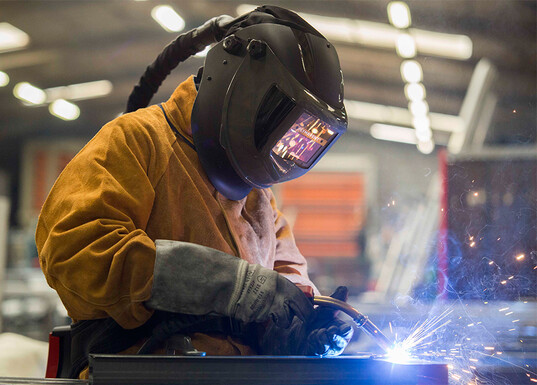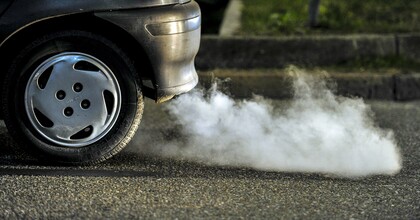It is common sense to keep welding fumes in the breathing zone of a welder below a certain limit [1]. Personal protection, source extraction and good general ventilation are the essentials for completing a welding job as safely as possible. Everybody should realise that personal protection is as important if not more so at this time, as Covid-19 (or the “coronavirus”) continues to spread worldwide.
Face masks everywhere
It is now common to see people wearing masks not just indoors but also outside. We have all been washing our hands more frequently and sanitising with antibacterial gel in an effort to halt the spread of the virus. However, studies show that a severe case of coronavirus has a far greater impact than other viruses. It’s not “just” another type of influenza. It leaves permanent scars on the lungs, the heart and even the brain, resulting in chronic fatigue and a host of other long-term effects[2].
Airborne dust as a transmitter
Professional welders should know that welding fumes are a mixture of airborne gases and fine particles. Recent studies, published in August 2020 in the American magazine Nature Communications[3], show that airborne dust is a far better transmitter of viruses than the respirational transmission that the general public has been warned about[4][5]. Welders operate in a uniquely dusty environment, which means additional precautions must be taken as we go about our daily work.
It is essential to know that it is not just normal breathing that makes us an easy prey for the virus. Not only fumes, but also airborne dust, fibres and other microscopic particles in those fumes can carry and transmit viruses like influenza and coronavirus. You must do even more to protect yourself and your co-workers and limit the inhalation of fumes while welding.
Clinging virus particles
Good, general ventilation and a fully functioning extraction system are paramount for your everyday welding work. Everybody in the welding field should be aware of that. And any good company take care of their welders, as they are the core of the company. Now that we know welding fumes are probably carrying far more particles of any virus than we could have ever imagined, we can take action to limit our exposure. The virus particles cling to these fumes and travel with them throughout the workspace. The less welding fumes one inhales, the safer you and your colleagues are. This was always the case, but it is even more important than ever right now. It is therefore highly advisable to extract as much of these fumes as possible right at the source using the latest ventilation technology.
It's better to be safe
Regularly inhaling welding fumes irritates the respiratory airways and lungs, enhances the risk of getting asthma and COPD, and increases the chance of getting lung cancer and damage to your internal organs. We also know that COVID-19 is a new disease and this disease has more impact on people with underlying medical conditions such as COPD and Asthma. The importance of using personal protection, source extraction and ventilation is these days maybe more important than before.
Keep your protection on
Welders may be used to taking off their RPE helmet and gloves immediately after the welding activity finishes. But welding fume that rises above the workpiece, and may escape at source solutions such as on torch or extraction arms if not positioned correctly, can stay in the atmosphere for up to 64 hours perhaps with a viral load. That is why if at source extraction is provided it must be used correctly. If at source extraction cannot be used, the various solutions to control welding fume building up in the facility should be considered.
It has never been just about the welder – everyone's health and wellbeing should equally important. We can all have been exposed to microscopic particles in the welding fumes that may or may not carry a virus. You cannot see them, so it’s better to be safe than sorry.
[1] https://publications.iarc.fr/569
[2] Jennifer Couzin-Frankel (2020, 31 July). From ‘brain fog’ to heart damage, COVID-19’s lingering problems alarm scientists. Consulted from https://www.science.org/content/article/brain-fog-heart-damage-covid-19-s-lingering-problems-alarm-scientists
[3] Sima Asadi, Nassima Gaaloul ben Hnia, Ramya S. Barre, Anthony S. Wexler, William D. Ristenpart, Nicole M. Bouvier. Influenza A virus is transmissible via aerosolized fomites. Nature Communications, 2020; 11 (1) DOI: 10.1038/s41467-020-17888-w
[4] Not just respiratory droplets, airborne dust & fibre particles can also spread coronavirus. The Economic Times, (2020, 18 august). Consulted from https://economictimes.indiatimes.com/magazines/panache/not-just-respiratory-droplets-airborne-dust-fibre-particles-can-also-spread-coronavirus/articleshow/77612466.cms?utm_source=contentofinterest&utm_medium=text&utm_campaign=cppst
[5] Setti L, Passarini F, De Gennaro G, et al Potential role of particulate matter in the spreading of COVID-19 in Northern Italy: first observational study based on initial epidemic diffusion, BMJ Open 2020;10:e039338. doi: 10.1136/bmjopen-2020-039338







